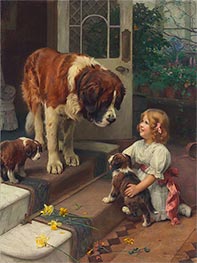
Arthur John Elsley Giclée Fine Art Prints
1860-1952
British Romanticism Painter
Arthur John Elsley, born in London on November 20, 1860, became one of the most popular painters of sentimental genre scenes in late Victorian and Edwardian England. His images of children, often accompanied by pets in idyllic countryside settings, resonated with the growing middle class, eager for art that celebrated domestic life and the innocence of childhood. These themes, so lovingly rendered, positioned Elsley as a master of capturing the idealized world of childhood - a vision that became a staple in homes across the country through widely reproduced prints, calendars, and advertisements.
His journey into art was shaped by a difficult early life. Elsley’s father, John, was an amateur artist who had exhibited a painting of horses in 1845, but illness forced him into caretaking work when Arthur was still a boy. Despite these hardships, Arthur showed early talent, sketching animals from life, and enrolling in the South Kensington School of Art by the age of fourteen. A serious case of measles permanently affected his eyesight, but it didn’t deter his dedication to his craft.
Elsley went on to study at the Royal Academy Schools, where he became deeply immersed in the academic traditions of the time, learning under respected figures such as Frederick Pickersgill and Edward Armitage. His first Royal Academy exhibit came at just 18, with "A Portrait of an Old Pony" in 1878, setting the stage for his future success. From the start, his skill with animals was evident, and he combined this strength with portraits of children, a combination that became his signature.
The turning point in Elsley’s career came with his partnership with Frederick Morgan, an established artist known for his genre scenes of children. Elsley, with his ability to depict animals, particularly dogs, began collaborating with Morgan, adding new depth to these popular domestic scenes. His work, "I’se Biggest" (1892), featuring a little girl measuring herself against a towering St. Bernard, became one of the most iconic images of the period, beloved for its charm and humor.
Elsley’s success was largely driven by the public’s appetite for art that reflected their own ideals of family and home. His paintings offered a reassuring vision of life - untouched by the industrialization and urbanization of the time. Children and pets, in natural, playful settings, symbolized purity and a simpler, gentler world. This popularity translated into commercial success, as his works were reproduced in various forms and became a staple of Victorian life.
Yet, his career was not without challenges. After a falling out with Morgan in the late 1890s, Elsley began to focus on more elaborate compositions, often featuring multiple figures and animals. His later years, however, were marked by declining eyesight, which limited his output, and by the time of his death in 1952, his work had largely fallen out of favor. But Elsley’s paintings remain evocative of a specific time and place - a nostalgic reminder of an idealized childhood, lovingly captured on canvas.
His journey into art was shaped by a difficult early life. Elsley’s father, John, was an amateur artist who had exhibited a painting of horses in 1845, but illness forced him into caretaking work when Arthur was still a boy. Despite these hardships, Arthur showed early talent, sketching animals from life, and enrolling in the South Kensington School of Art by the age of fourteen. A serious case of measles permanently affected his eyesight, but it didn’t deter his dedication to his craft.
Elsley went on to study at the Royal Academy Schools, where he became deeply immersed in the academic traditions of the time, learning under respected figures such as Frederick Pickersgill and Edward Armitage. His first Royal Academy exhibit came at just 18, with "A Portrait of an Old Pony" in 1878, setting the stage for his future success. From the start, his skill with animals was evident, and he combined this strength with portraits of children, a combination that became his signature.
The turning point in Elsley’s career came with his partnership with Frederick Morgan, an established artist known for his genre scenes of children. Elsley, with his ability to depict animals, particularly dogs, began collaborating with Morgan, adding new depth to these popular domestic scenes. His work, "I’se Biggest" (1892), featuring a little girl measuring herself against a towering St. Bernard, became one of the most iconic images of the period, beloved for its charm and humor.
Elsley’s success was largely driven by the public’s appetite for art that reflected their own ideals of family and home. His paintings offered a reassuring vision of life - untouched by the industrialization and urbanization of the time. Children and pets, in natural, playful settings, symbolized purity and a simpler, gentler world. This popularity translated into commercial success, as his works were reproduced in various forms and became a staple of Victorian life.
Yet, his career was not without challenges. After a falling out with Morgan in the late 1890s, Elsley began to focus on more elaborate compositions, often featuring multiple figures and animals. His later years, however, were marked by declining eyesight, which limited his output, and by the time of his death in 1952, his work had largely fallen out of favor. But Elsley’s paintings remain evocative of a specific time and place - a nostalgic reminder of an idealized childhood, lovingly captured on canvas.
3 Arthur John Elsley Artworks

Giclée Canvas Print
$62.03
$62.03
SKU: 18050-AJE
Arthur John Elsley
Original Size:83.2 x 62.2 cm
Private Collection
Arthur John Elsley
Original Size:83.2 x 62.2 cm
Private Collection

Giclée Canvas Print
$72.71
$72.71
SKU: 18051-AJE
Arthur John Elsley
Original Size:88.9 x 101.6 cm
Private Collection
Arthur John Elsley
Original Size:88.9 x 101.6 cm
Private Collection

Giclée Canvas Print
$59.77
$59.77
SKU: 18052-AJE
Arthur John Elsley
Original Size:78.4 x 109.2 cm
Private Collection
Arthur John Elsley
Original Size:78.4 x 109.2 cm
Private Collection